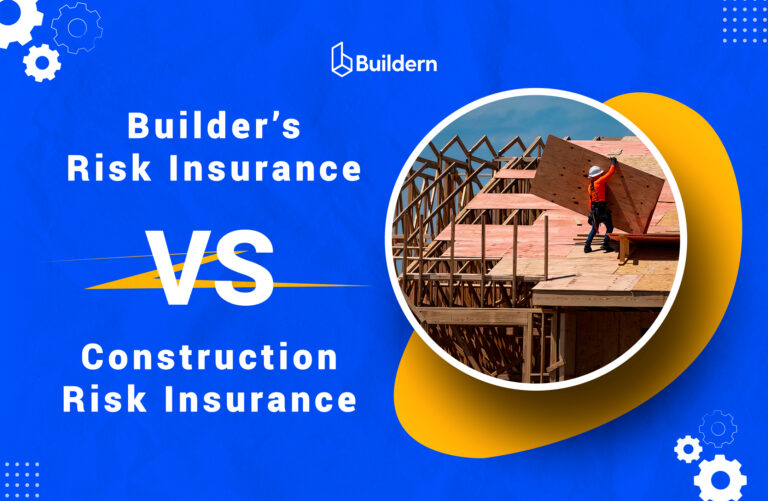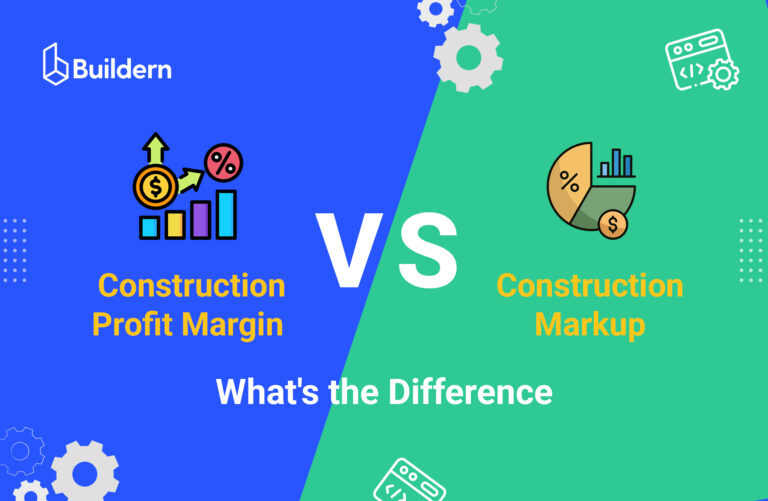Building a Dynamic Cost Catalog for Custom Homes: Tips on How to Structure Data
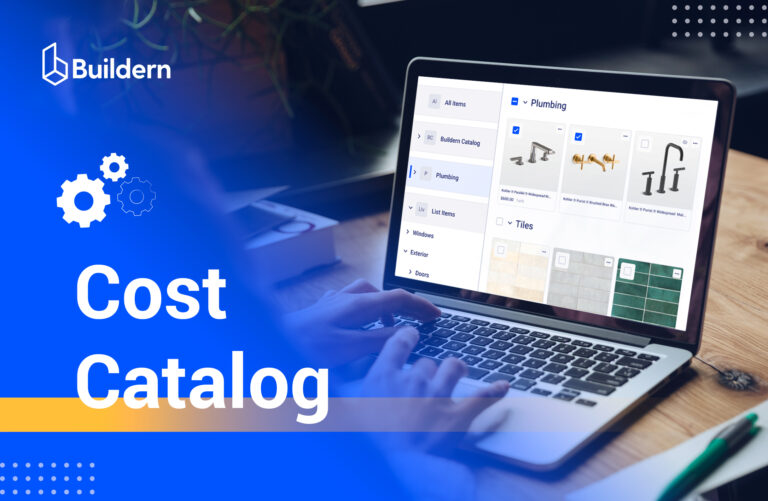
Dealing with a house means having in mind thousands of details. From blueprints and design adjustments to changing material prices, all this data is at the core of every construction project.
When it comes to a custom home, there are even more items, as there is no template and everything changes in a second. A general contractor needs a reliable structure for cost tracking, such as a cost catalog.
For custom home builders, a structured approach is important for sharper accuracy in estimates and better workflows across the office and field teams. In this blog, we will figure out how to build a dynamic cost catalog tailored for custom homes.
Table of Contents
- The Basics of a Cost Catalog in Construction
- Why Custom Home Builders Need a Cost Catalog?
- Top 4 Benefits of Cost Catalog
- Key Elements of Having a Cost List
- Best Practices for Having Costs Updated
- Using Technology to Manage Your Cost Catalog

The Basics of a Cost Catalog in Construction
In construction, this is a database that brings together all construction cost components, including materials, labor, equipment, and subcontractor rates.
Instead of having item names, numbers, and visuals across different spreadsheets, emails, and vendor notes, builders can rely on a single inventory.
Of course, in the past, after notebooks and notes on a PC, having a static spreadsheet was a step ahead. However, today, with more digital tools, a static list cannot satisfy the needs of a general contractor who deals with several projects simultaneously.
- A static spreadsheet holds fixed numbers that require manual updates. Each time you update the costs of materials or labor, you have to enter another file to update the estimate or make shifts in schedules. Too many manual actions if you are running, for example, 3 projects.
- A dynamic cost catalog enables a builder to adapt the prices in real time. As vendor pricing, labor rates, or material costs shift, the catalog can be updated once and applied across all future and present estimates and budgets.
For custom home builders, this flexibility is crucial. Each project has unique requirements, and relying on outdated cost data can quickly affect the budgets and client trust.
Thus, the cost catalog becomes a crucial component of financial management. Besides, this helps the general contractor minimize the risk of accidentally sending the same bid request multiple times.
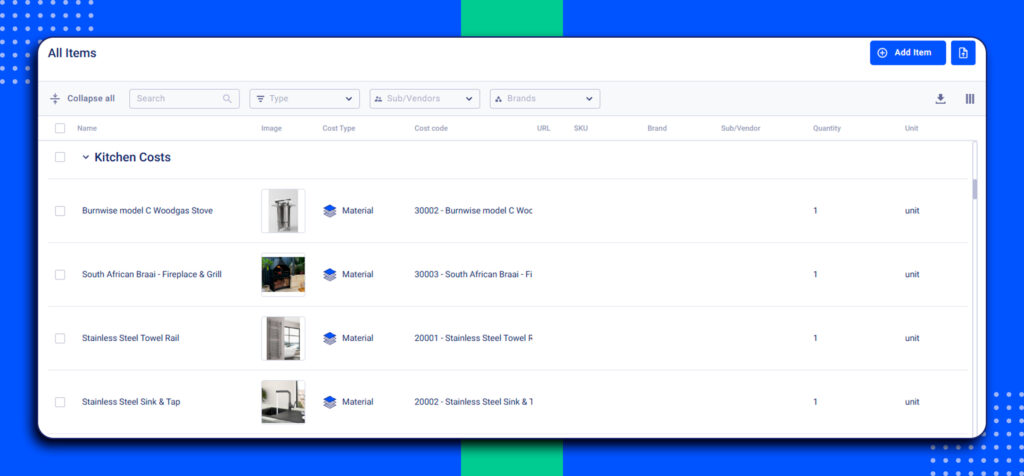
A well-structured cost catalog ensures estimates remain accurate, bidding is competitive yet profitable, and budgeting reflects the true scope of the work.
Why Custom Home Builders Need a Cost Catalog?
Custom home projects differ from others in their complexity. No two houses are exactly alike. This makes estimating far more challenging than with spec home projects.
Without organized data to rely on, general contractors often face a number of obstacles.
- Difficulty tracking material price changes: Material management is a tough task, as costs can change even within weeks. It’s difficult to track sudden fluctuations in a static spreadsheet
- Subcontractor confusion: Miscommunication or duplicate bid requests may affect schedules and budgets.
- Duplicate work: Entering data and prices for hundreds of items multiple times increases the chance of errors.
Meanwhile, a cost catalog helps builders manage these uncertainties. You have a dynamic database of costs with faster and more accurate estimates that reflect current market conditions.
Top 4 Benefits of Cost Catalog
A custom construction project usually involves a team of professionals, including the office and field workers.
If estimators are involved, this may appear that they use a different approach, creating discrepancies. Therefore, it’s essential to have one database to be a guideline during a complex project that may last several months.
Let’s see what the key benefits of having all costs in one place are:
#1 Quick Response to Cost Fluctuations
When material or labor prices change, updating them once in the catalog automatically applies to all estimates and budgets.
#2 More Accurate Estimates
Custom home builders can quickly pull accurate pricing for specialized materials, unique architectural features, and region-specific labor rates.
#3 Consistency Across All Projects
A standardized cost catalog ensures that similar work items are priced consistently, regardless of which team member prepares the estimate.
#4 Faster Change Order Process
If there is a change order, the builder can adjust estimates in minutes by pulling costs directly from the catalog.
Most importantly, having a huge database within reach simplifies the decision-making process. For example, when helping a client choose a design or plan adjustments during construction, making a key decision that will affect the entire project takes less time as it is based on accurate data rather than rough estimates.

Key Elements of Having a Cost List
The more detailed a catalog is, the better. Of course, it can include a wide variety of items, but its real value comes from being organized as a hierarchy of items.
For example, when every cost item falls under a family of related items. This hierarchy not only makes data easier to reach but also ensures consistency and accuracy across all projects.
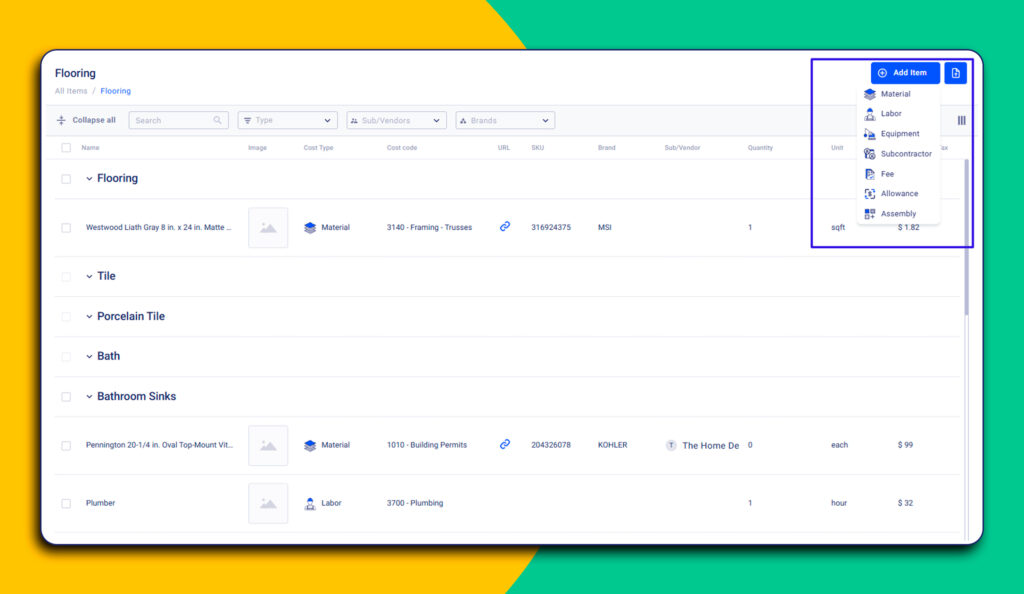
Cost Codes
The first to start with are cost codes, standardized identifiers used to organize and track construction costs across different categories of work. They group expenses into logical segments, such as labor, materials, equipment, or specific trades like electrical or plumbing. This structure helps in preparing estimates and monitoring budgets.
Cost codes are typically formed by following established industry standards, such as the CSI MasterFormat or NAHB classifications. However, builders can also create custom codes.
A cost catalog can be built on this foundation. By linking each catalog item to a cost code, builders ensure all project data can be easily monitored.
Now, let’s go deeper into a structured system of a cost catalog that includes the following items.
Materials and Equipment
There are not only raw construction inputs, but everything from base materials like lumber, steel, or concrete to finished parts such as sinks, tiles, or cabinetry.
Each material entry can carry its own detailed description, along with an image, brand specification, quantity, and even tax information. Markups can also be applied at the item level, giving builders flexibility when preparing estimates. The same applies to equipment prices. Within a cost catalog, each equipment entry can be defined with a category, unit type, and price. It can also include details about the subcontractor or vendor providing the equipment, making it easier to compare rates.
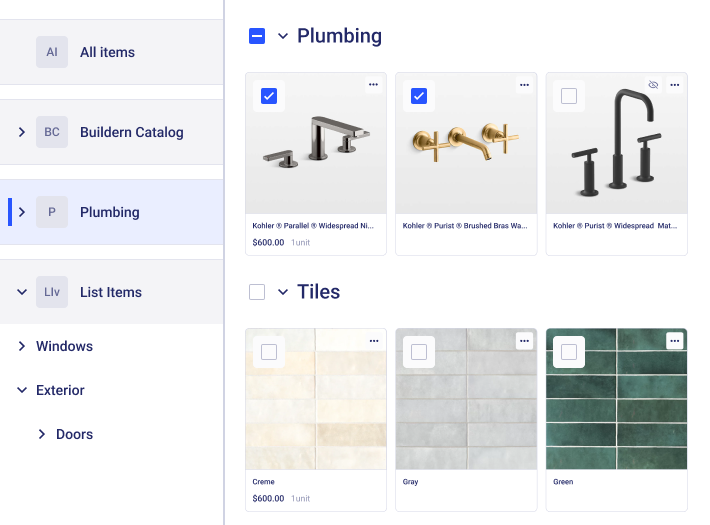
Labor
The catalog also features the full scope of workforce expenses. Each labor item can include a name and description of the work performed, the subcontractor or trade it belongs to. The number of hours and the cost are also here. This is also useful to add markup percentages and applicable taxes directly at this stage to have an accurate estimate later.
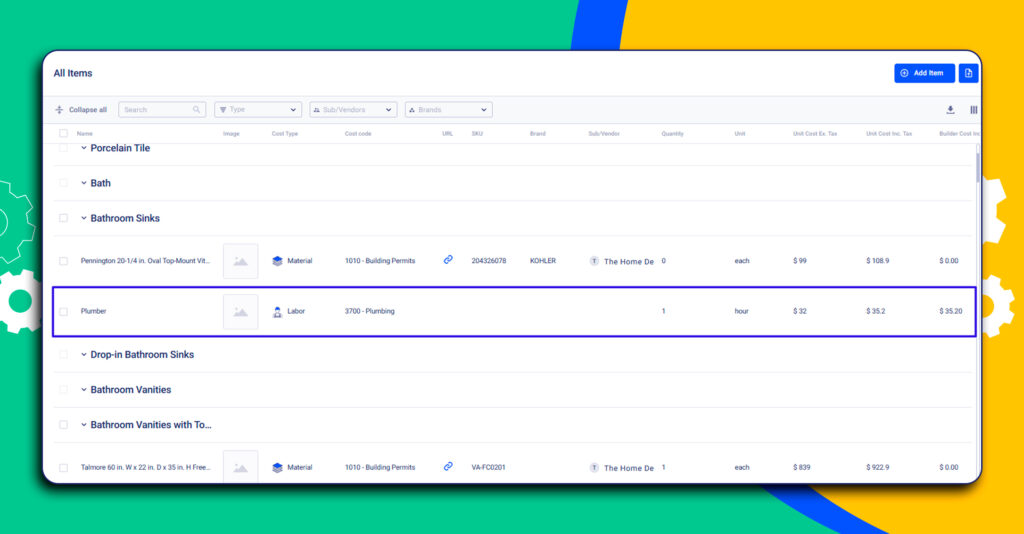
Subcontractor Fees
For custom home builders, subcontractors are a core part of nearly every project. Their costs can significantly influence overall budgets. Subcontractor fees in a cost catalog ensure these expenses are updated and applied consistently.
Allowances
Sometimes, it’s impossible to finalize every choice at the estimating stage. Clients can change their minds when it comes to finishes like flooring, cabinetry, or light fixtures when a project begins.
Including allowances in this list means builders have a realistic budget that can be later changed if the client makes a final decision. This avoids disputes later and helps a builder and a homeowner to have more clarity during all stages of the project.
Best Practices for Having Costs Updated
Having all prices in one place is a great idea, but the follow-up is more important. Even a well-structured catalog can lose value if the data is not updated.
To make sure your catalog continues to serve as a foundation for estimating and budgeting, it’s important to consider the following:
- Regularly update data with Sub/Vendor feedback: Prices for materials and equipment fluctuate often. By checking in with subcontractors and vendors, general contractors can ensure estimates reflect real market conditions.
- Involve project managers and estimators in catalog reviews: A catalog shouldn’t be static. Project managers and estimators, who work with cost data every day, can make changes and update missing items.
- Use construction software integrations: Connect your catalog with estimates and budget. Automated syncing reduces manual entry and keeps pricing in compliance with current market rates.
Using Technology to Manage Your Cost Catalog
Instead of keeping all costs in different files and messages, general contractors can use construction management software. The clear benefit of having all prices structured is that you can import the prices, for example, from a spreadsheet, and use them during the entire project.
Moreover, there is no need to enter prices and visuals manually. Once you have all sorted out, the data automatically goes to the estimate and later to the proposal.
This means finding the costs, for instance, for a kitchen sink takes a few clicks. A general contractor just picks an item from the cost catalog when creating the estimate.
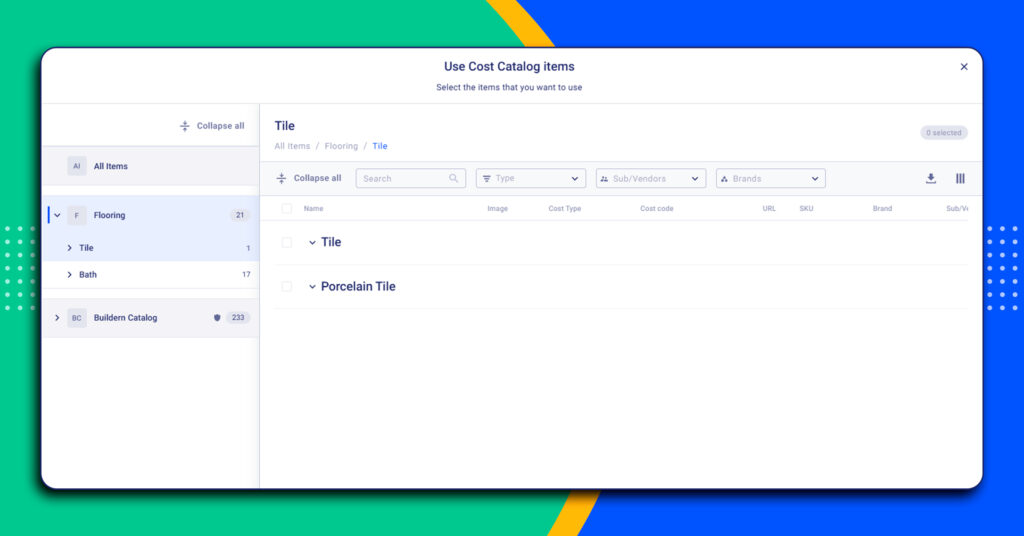
How Are Cost Catalogs Structured?
A clear structure is a must for any cost catalog. There should be a division into materials, labor, subcontractors, allowances, and other items. The so-called family includes subordinate items related to the same category. Meanwhile, assemblies let you group multiple cost items into a single reusable package. Instead of adding each item one by one, you can select an assembly (e.g., a bathroom setup or wall framing) and automatically pull in all related costs at once.
What’s the Difference Between a Spreadsheet and a Dynamic Cost Catalog?
A static spreadsheet holds fixed numbers and requires manual updates anytime the costs change. A dynamic catalog, on the other hand, updates prices once and applies them across all project management cycles, like creating estimates, forming proposals, and managing budgets. This ensures accuracy and saves time.
How Can Software Improve Cost Catalog Management?
When using digital tools, builders can import costs directly from spreadsheets, update vendor pricing, and use the data across estimates, budgets, and proposals. This minimizes manual entry and speeds up processes like creating estimates or change orders.
Key Insights
A dynamic cost catalog is a basis for accurate estimating and efficient project management for custom home builders.
By organizing costs into clear categories like labor, materials, and subcontractors, contractors can ensure consistency during all phases of projects, even if the general contractor has several projects running.
It also requires some work to keep pricing relevant. Unlike static tools, a dynamic catalog adapts instantly to market shifts and helps make proposals more accurate.

